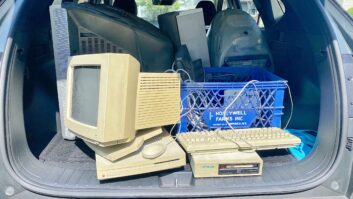
It wasn’t that long ago that Mix would break new product information in a monthly print issue. We were the media, the primary gatekeepers of information. We had contacts, we received press releases, we got phone calls about upcoming “exclusive” product launches or “special access” to tours. A producer might call about an album project that nobody even knew was taking place. And we got to tell the world about it, every 30 days. There was a staff of 40-plus, and the magazine was fat.
Then came the Internet, followed by mobile, and the music and publishing worlds changed dramatically and forever. Thankfully, Mix stabilized a few years back, albeit in a much slimmer print form, and the recording industry seems to be settling into its new hybrid form. Products are still put out, audio projects are more numerous than at any time in history, and new revenue models for studios, recordings and distribution will eventually find a way to bring the money back. But I suffer no illusions: Mix will never return to its halcyon days of 228 pages a month.
So what’s an editor to do? I used to edit in-depth technical articles, featuring schematics and specs and titles like “Clocking and Conversion” or “Perceptual Coding.” Excellent articles, bordering on the AES Journal in their approach. But with only 52 pages a month, what goes and what stays? I’ve thought long and hard about that these past 10 years.
In a nutshell, I keep coming back to stories. The Internet is overloaded with information. If you need a schematic to repair an old Studer tape machine, you can find the parts in an online search and then watch a video on YouTube rather than run down the manual. If you need a studio’s equipment list, the studio’s site has it. If you need a manufacturer’s stated frequency response graph, it’s easily searchable.
Mix is a features magazine, and it’s a product review magazine. That’s our core. Mix has access to top talent in the industry and the opportunity to go behind the scenes at major events or major releases. That’s what we do. We’re fortunate to have a sister publication in Pro Sound News, and its editor Clive Young, who is committed to his mission of news and business. He’s good at it. Mix is good at stories—feature stories on studios, music, recording, tours, films, universities, design, new technologies, industry trends, emerging talent and countless other aspects of our industry.
All of this came to mind this month while editing the issue, where we have a number of damn fine stories.
Look at the cover. We’ve all heard about Brooklyn and how it became a hipster haven and hotbed of recording once Manhattan prices forced out artists, same as they did big commercial studios. That started more than a decade ago, and Strange Weather Studios was part of it. But then Marc Goodman started thinking bigger, and he met engineer Daniel Schlett, and the two zigged while the rest of Brooklyn zagged, and they built a world-class, single-room, API and analog-centric facility in 2012 at a time when the rest of the recording industry seemed to be scaling back in major markets. It has sure worked out well for them. And it’s a good story.
We also have Grace Potter sit for an interview, where we emphasize her story, especially as it relates to her life in music and her reluctance to record again. Last December we told the story of her husband, Eric Valentine, an in-demand producer who also happens to own Barefoot Studio and UnderTone Audio. The technical detail is almost a bonus in this case, and we’re fortunate that Grace and Eric’s stories come together on a very personal record. That’s a good story.
And Raphael Saadiq? He could talk all day about recording and analog/digital and building grooves, but this story is about how the death of his brother, Jimmy Lee, informed his current release. He’s human. He’s real. And you can likely find most of the technical information elsewhere. This is what matters to him, right now.
And Audio Test Kitchen? Here’s Alex Oana, a guy with an idea. He sees a hole in the pro audio retail chain. He meets another guy, Ian Hlatky, and they spend three years bringing the idea to market. It must have felt like a lifetime in today’s world. But this month they launch an online search/comparison tool for listening to analog products and comparing them against others—providing an objective, nonbiased source for what is most often a very subjective decision. The amount of work that has gone into building just the large-diaphragm condenser microphone category is staggering, and there are many more categories to come. It’s a good story.
I wish I had room to talk about Moulin Rouge! The Musical. Tony Savona has penned an excellent piece on the making of a cast album in the midst of a hit Broadway show’s run.
Yes, we still do plenty of product news and the product review section remains a bedrock. But when a good story comes in, we have to tell it…







